Many players are not excited to talk about lands. It’s arguably the most boring part of MTG.
But we should look more closely at them because they account for around 40% of your main deck.
Think about that. 40% of the cards you will see while playing MTG are lands. Yet, we hardly see articles talking about this huge chunk of your deck.
I get it. Lands are boring compared to exciting creatures and spells. However, if you do the work of analyzing the lands of a format, you will gain an advantage over the competition because most players don’t do it.
To help you get started with this process, I’ve written this guide as a basic intro for how to think about the meta by looking at its lands.
Only Basic Lands
Imagine a format where the only lands available are:
Plains
Island
Swamp
Mountain
Forest
Wut?!
You’re probably wondering, “Why are we doing this?”
Well, it turns out one of the best ways to learn card game theory is to simplify the game by a lot. This helps you to see concepts more clearly.
For example, one of the best poker books is Play Optimal Poker. Poker is a very complex game so the author sets up a toy game with just three cards: Jack, Queen, and King.
The simple toy game has helped many people become better poker players including myself.
MTG is even more complex than poker so we’re going to set up toy metagames to help us understand the theory.
Ok, with that out of the way, in this “basic land only” format, which decks are more likely to succeed?
The best decks will probably be mono-colored.
If you try to play a two-color deck with 12 mountains and 12 forests, it won't be very consistent.
From a meta perspective, to play two colors, the cards in your deck need to be much stronger than the cards in a mono-color deck. This is because consistency is crucial to winning games. If you can't cast your spells due to a poor mana base, you'll lose. To overcome this drawback, you need to be compensated with a much higher power level from your nonland cards.
Historically, we've seen this scenario before. In a format without dual lands, players had to ensure their two-color decks were powerful enough to justify the inconsistent mana base.
Check out the winning deck of Pro Tour Osaka 2002: Simic Madness. Its mana base is an abomination. 🤣
13 Forest
9 Island
1 Tarnished Citadel
Tarnished Citadel can give either color of mana but it deals 3 damage to you each time!
But the deck did well because the Simic cards were powerful enough to overcome the crappy mana base.
I wouldn’t try this at home though unless you are a very advanced player or the deck has proven itself in competitive tournaments.
We all have our biases. We want to believe the cards we’re playing are more powerful than they really are. This leads many of us into playing suboptimal mana bases that are not worth it.
In a format with only basic lands, just stick to mono-color decks.
Adding Allied Color Pain Lands
Let’s add these five lands to our toy metagame.
Adarkar Wastes (W/U)
Underground River (U/B)
Sulfurous Springs (B/R)
Karplusan Forest (R/G)
Brushland (G/W)
What types of decks are going to do well in this format?
Now we can play two colors. We don’t need a huge power discrepancy over mono-color decks because the two-color decks became more consistent.
A two-color deck that used to be Tier 2 could very well become the best deck in the new format. That’s the power of a more consistent mana base. It increases your win rate by a lot.
Also, note that we only added the allied color pain lands. We did not add the enemy color versions like Llanowar Wastes (B/G).
Therefore, if you’re choosing between an aggro Boros or Gruul deck, pick Gruul unless you have clear evidence that the Boros power level is much higher.
This type of meta change, where only certain color pairs get a dual land, has happened in past Standard formats. Sometimes it’s like this example, where only allied colors get a boost. Other times, it’s a hodgepodge of additions like three allied colors and three enemy colors.
What you’ll find in these situations is the Tier 1 two-color decks are usually the ones with a dual land. For the lacking color pairs, the lower consistency is often too hard to overcome.
What about thinking in terms of the three main deck archetypes: aggro, midrange, and combo?
How do the archetypes stack up against each other?
When analyzing the metagame, check if the multi-color lands come into play untapped on turn one. Pain lands do, which benefits aggro. Aggro decks want to win with aggressive creatures on turn one.
On the other hand, control decks want to play longer games and they usually don’t have important cards to cast on turn one.
Also, these are pain lands so they cause pain. Aggro doesn’t mind. They are designed to kill before the life loss matters.
But the lands are a nonbo in control. As a control player, you don’t want to have a pain land while facing an aggro deck. The pain land damages you, making it easier for the aggro deck to kill you.
Midrange decks are also at a disadvantage, though not as much as control decks. The difference between midrange and control is length of games. Control decks will play more turns, which means taking more damage from the lands.
Therefore, if you’re comparing an aggro Gruul deck, a midrange Selesnya deck, and an Azorius control deck with equal power levels, go with the aggressive strategy.
Replacing Pain Lands with Scry Lands
What if, instead of allied pain lands, we replaced them with the allied scry lands?
Temple of Enlightenment (W/U)
Temple of Deceit (U/B)
Temple of Malice (B/R)
Temple of Abandon (R/G)
Temple of Plenty (G/W)
We’ve actually had Standard formats where these lands were among the best lands.
In this metagame, aggro takes a big hit. Aggro is predicated on having aggressive one-drops. These lands are a hinderance to that strategy because they enter tapped.
Midrange and control have zero to few important plays on turn one. These decks thrive in a meta full of tapped lands like scry lands.
Pain Lands + Scry Lands
Let’s add back the pain lands. In fact, let’s include the enemy-colored versions of both pain lands and scry lands. So now, our meta looks like this:
10 Pain Lands
10 Scry Lands
Now we have something that looks like an actual Standard metagame.
How should we think about this format?
I think this is where midrange has the advantage over aggro and control.
Aggro doesn’t want to play scry lands. Control doesn’t want to play pain lands.
But midrange can use both lands effectively. It does not have important turn one plays like control so it does not mind the scry land drawback. And while pain lands are better for aggro decks, midrange are okay with them. Midrange games end faster than control games, so it won't take as much damage from pain lands.
Also, based on recent times, midrange tends to get good lifegain cards, which neutralizes the damage from pain lands. In the current Standard format, we see these midrange lifegain cards doing well in the format:
Deep Cavern Bat
Sheoldred, the Apocalypse
Tranquil Frillback
Gix's Command
Aclazotz, Deepest Betrayal
Control decks can also have good lifegain cards but not as many as midrange, at least based on recent history. The Wandering Emperor is a top card in Standard. It works well in control decks by providing lifegain to survive against aggro.
With all the additional lands, you can now play eight dual lands in a two-color midrange deck. Going from one to two colors generally results in a higher power level. Therefore, if you’ve been playing a mono-color deck, it’s time to ask yourself if it’s worth it to add a color.
You’ll lose some consistency but not much since there are now eight dual lands. Oftentimes, it’s worth it to add a color to your deck when new dual lands enter the format.
Five Tri-Lands Enter the Meta
Let’s add the five shard-colored tri-lands to the mix. So now, our meta is this:
10 Pain Lands
10 Scry Lands
Spara's Headquarters (G/W/U)
Raffine's Tower (W/U/B)
Xander's Lounge (U/B/R)
Ziatora's Proving Ground (B/R/G)
Jetmir's Garden (R/G/W)
Hm… this is starting to look like the current Standard format.
We have a lot of options for multi-color. You really have to have a good reason to play just one color.
Also, three-color decks become a real possibility. I would stick with midrange or control decks because the tri-lands enter tapped.
Given that this meta is similar to current Standard, we can make some observations regarding the Tier decks. The top decks with three or more colors have a matching tri- land or they have another land(s) that allows them to consistently play many colors.
Esper Midrange has Raffine's Tower.
Domain is a base Bant deck that uses Spara's Headquarters. The deck only splashes a few late game cards in the fourth and fifth colors. You can often get away with an extra color or two if you’re playing base green because it is the color of mana fixing.
The rest of the top decks with three or more colors include Temur Analyst (Land Combo), Bant Toxic, and Legends.
Temur Analyst is able to play three-colors even without the matching tri land (in this case, matching sac tri-land) because it plays 30 lands.
Bant Toxic has The Seedcore. Even with this land, the deck has the worst mana out of the top decks in Standard. It is a Tier 2 or 3 deck. If it had a better mana base, it might be a Tier 1 deck.
The Legends deck gets away with playing many colors because it plays 29 lands and has the five-color land, Plaza of Heroes. The deck can play 29 lands because it uses legendary lands like Otawara, Soaring City that can act as spells.
Notice there are no aggro decks with three colors or more except for Bant Toxic. The tapped nature of the tri-lands makes it prohibitive to play three-color aggro. Bant Toxic is an exception because it has an untapped colored land that pumps your creatures (The Seedcore).
This quick analysis of the current meta was more advanced than I intended but I hope it demonstrates how much lands affect a metagame.
You don't see Jeskai, Sultai, Abzan, or Mardu doing well because it's tough to play three colors without a tri-land. The exception is Temur because it can play 30 lands.
The analysis above is also important because Standard rotates on August 2, 2024. On that date, the new expansion Bloomburrow will be released and four sets will leave the format.
Many people may want to keep playing a three-color deck like Esper post-rotation. Maybe they found success with Esper in the recent past. Or they like the play patterns of the Esper deck.
However, I would advise against that because all the Esper tri-lands including the sac lands will leave the format. This means Esper will be much weaker unless Bloomburrow has an Esper tri-land.
This seems very unlikely based on current set information. From this wiki, Bloomburrow has “double cycles”, which are two-color combinations, not three.
Let me save you some time. Don’t build three-color decks for post-rotation. You will build bad decks and lose games.
(I'm actually writing this as a warning to myself. I have a weakness for dipping into an additional color when I shouldn't.)
Go with two colors because there are many dual lands. If you really want to play three colors, look at green because it has mana fixing.
Also, since there are many dual lands, I don’t recommend building mono-color decks.
Pop Quiz
I hope you found this basic guide helpful. Let's take a quiz to give you some practice for analyzing the format in terms of lands.
For the following toy metagames, ask yourself, “How does it affect aggro, midrange and control?”
Answer the question in your head for each meta. This is very important for learning and self improvement.
Then, go to the comment section to see my answers.
Meta #1: Fast Lands
This meta has the 10 fast lands. All the two-color pairs are represented. Fast lands enter tapped unless you control two or fewer other lands.
Meta #2: Slow Lands
This meta has the 10 slow lands. All the two-color pairs are represented. Slow lands enter tapped unless you control two or more other lands.
Meta #3: Creature Lands
This meta has 10 creature lands like the one above. All the two-color pairs are represented. The creature lands in this meta all enter tapped.


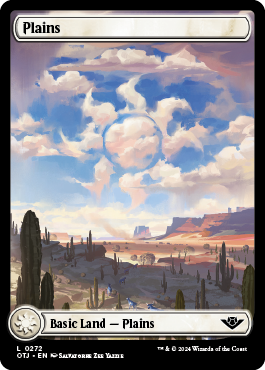
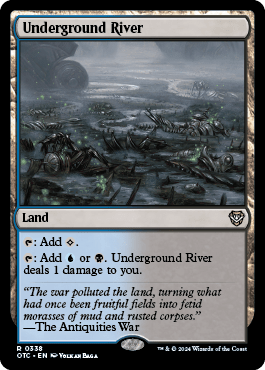


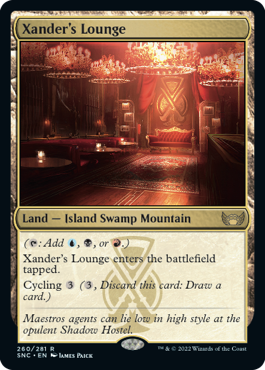

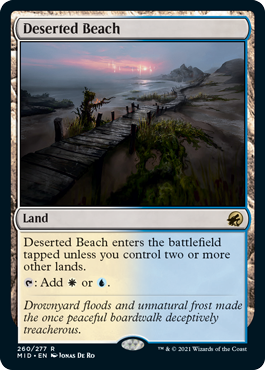
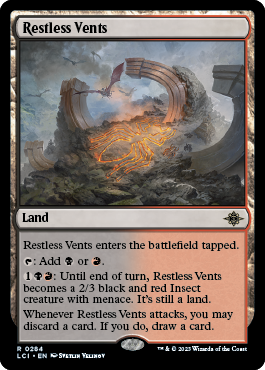
Meta #1: Fast Lands
This meta favors aggro. Fast lands are good on turns 1, 2, and 3, which is the sweet spot for aggro.
Fast lands are not good with cards that cost four or more. Midrange and control have more of those cards than aggro.
I would look to play aggro in this format.
Meta #2: Slow Lands
This meta favors midrange and control. Slow lands are bad on turns 1 and 2. They are great afterwards.
Midrange and control have more cards that cost three or more than aggro.
Therefore, I recommend avoiding aggro.
Meta #3: Creature Lands
You may think this helps aggro because the land can attack, but midrange and control also get a land that can block.
Having a turn one play is so important for aggro that it gets dinged in this meta.